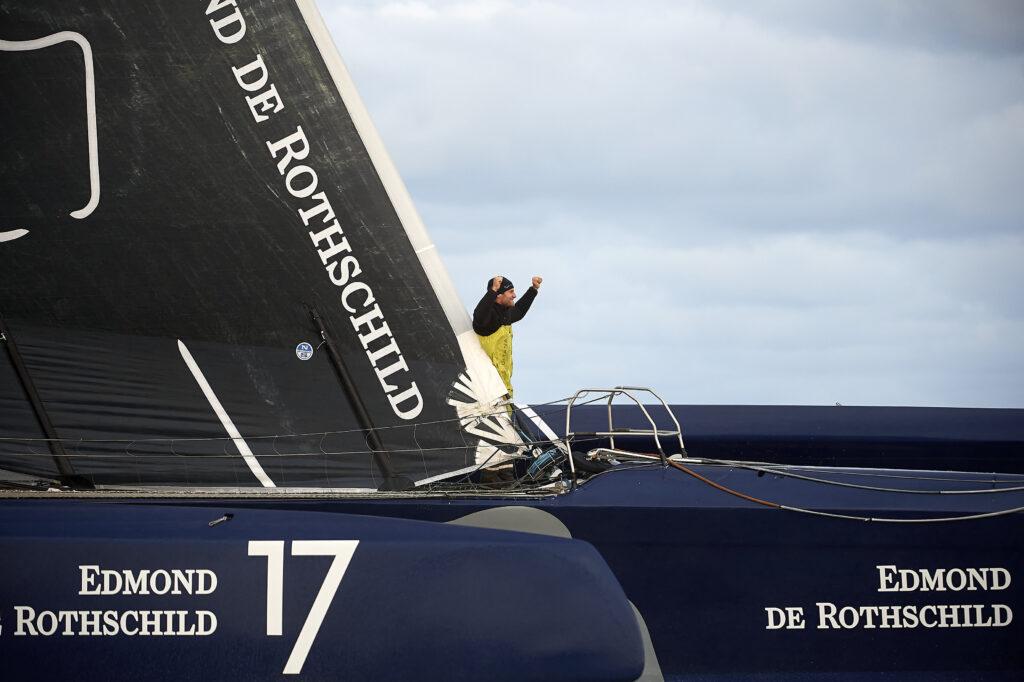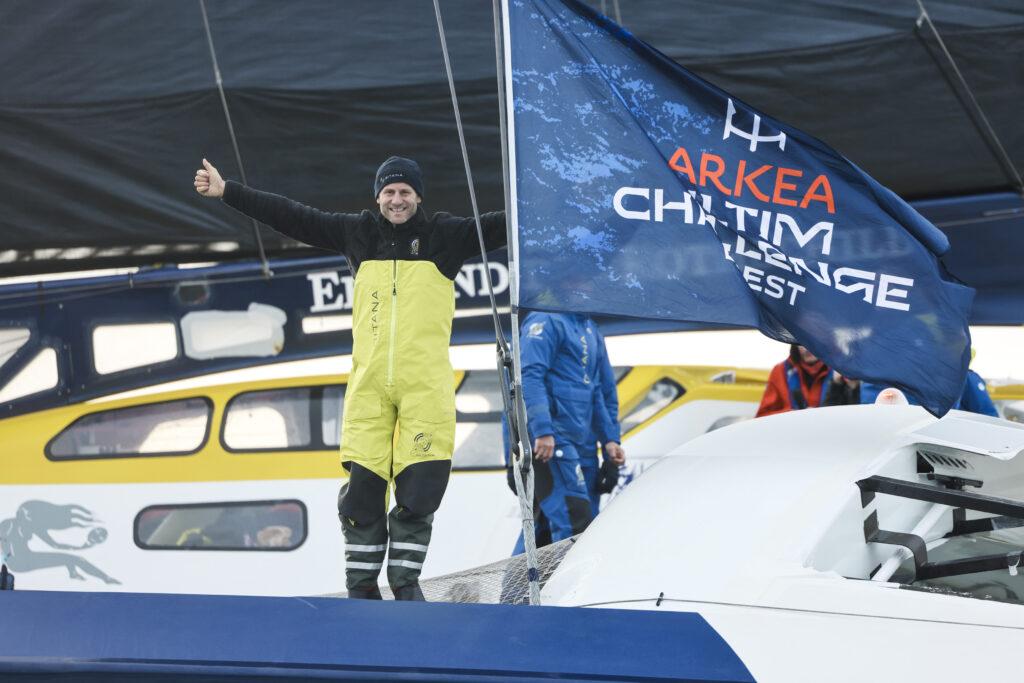
Arrivée du 1er avant jury de l'Arkéa Ultim Challenge-Brest, Charles Caudrelier, Maxi Edmond de Rothschild, ARKEA ULTIM CHALLENGE - Brest, le 29/12/23
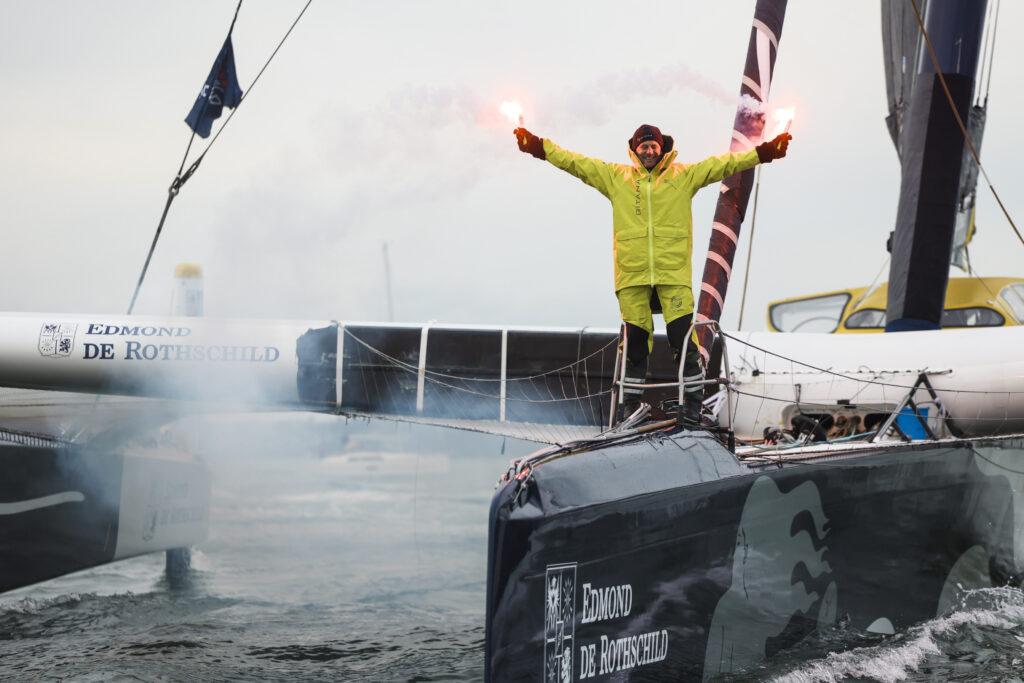
Blessed with a perfect sunrise, flat seas and a modest 15kts breeze as he approached the long awaited finish line off Brest this morning Charles Caudrelier took time to enjoy the final ten miles of his solo multihull race round the world.
Required for many days to moderate the speed of his Maxi Edmond de Rothschild to make most sure of closing out an impressive victory, Caudrelier lit the afterburners and flew at nearly 40 knots for a sustained period in the early morning sun, as it to remind himself, and the 100 thousand or so race fans watching on line, of the sheer unbridled speed potential of the flying, foiling ULTIM.
One day after his 50th birthday Caudrelier crossed the finish line off Brest at 08:37:42hrs local time this morning to win the inaugural ARKÉA ULTIM CHALLENGE-Brest, the first ever race round the world for 32m high speed foiling ULTIM multihulls.
His elapsed time for the 22,460 nautical miles course, which left Brest on Sunday 7th January is 50 days 19hrs 7 mins 42 secs. He sailed an actual course of 28,938 miles on the water.
After losing his nearest rival when 26 year old Tom Laperche’s SVR Lazartigue struck an object on the 18th day of the race and had to retire into Cape Town, the lead of Caudrelier extended to the equivalent of six days at one point after the second and third placed skippers had had to make successive technical stops in Brazil and Hobart.
Along the way he set a new solo record for the passage from Ushant to Cape Leeuwin, 18 days 5 hours 44 minutes, and for the Indian Ocean between Cape Agulhas and Tasmania’s South East Cape in a time of 8 days and 8 hours. But the Pacific Ocean was less kind to him and he had to pause just after Point Nemo – some 1300 miles west of Cape Horn – to avoid a big storm at the fearsome tip of South America.
Last week he was able make a strategic stop into the Azores to avoid one final Biscay gale – storm Louis – before completing the final 1200 miles with this perfectly timed, perfectly executed finish this morning.
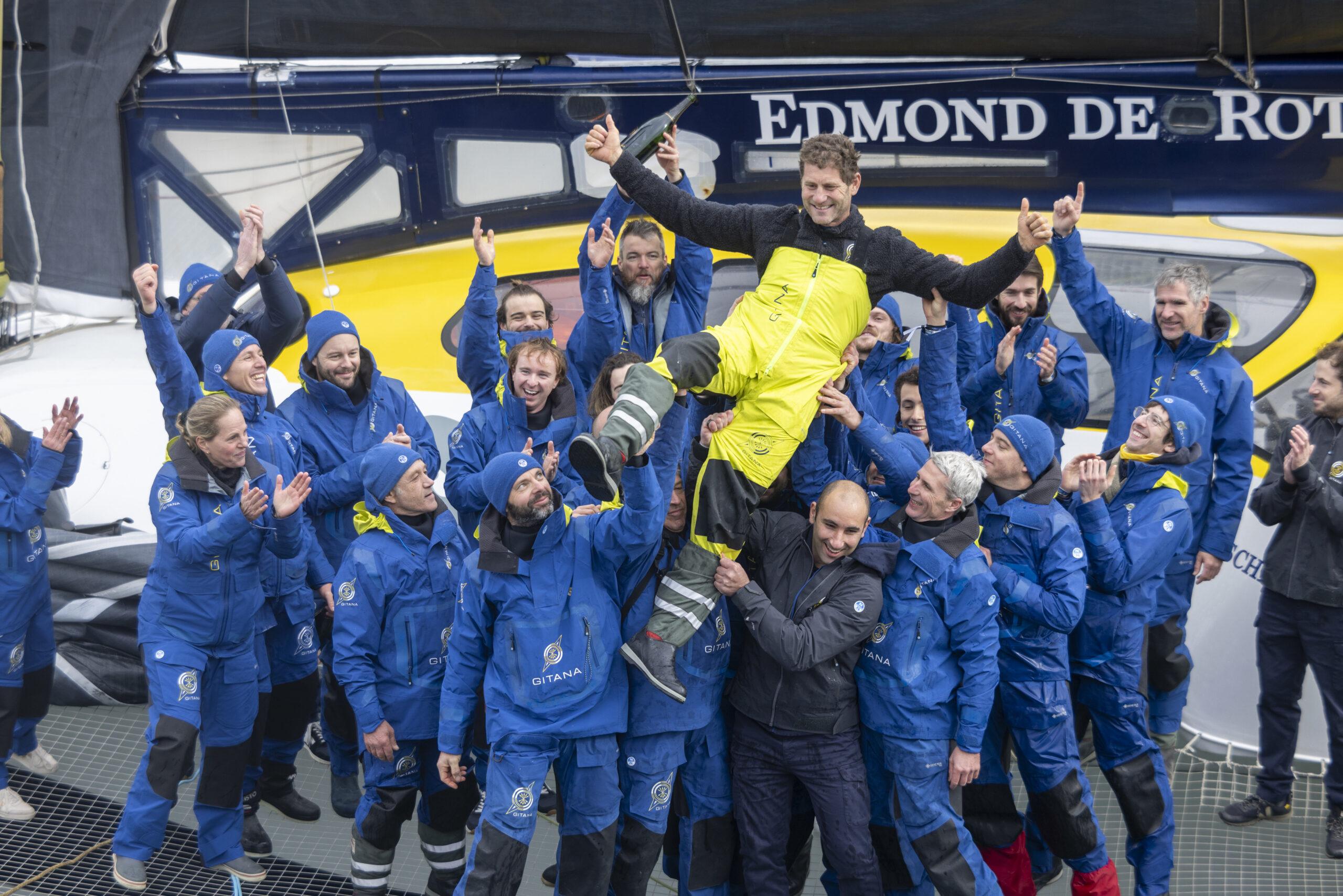
Caudrelier rewarded
His win rewards his remarkable work ethic, a strong appetite for self-sacrifice, perseverance and a powerful sense of community, family and teamwork which also underpinned his successful leadership of the winning Chinese backed Dongfeng team on The Ocean Race. His solo triumph today is a just reward for the immaculately run historic Gitana team’s multihull project which started almost ten years ago.
And so the Paris born, former Merchant Marine officer Caudrelier, at 50 years and one day old, has become the Ultimate ‘Ultim’ sailor, the one who sailed best on the best prepared, most optimised and reliable giant ULTIM, to win this inaugural, first ever round the world race in a multihull and solo.
Caudrelier is a sailor who has always enjoyed sailing alone and who dreamed of emulating the solo success of the heroes of his youth, names such as Michel Desjoyeaux and Jean Le Cam. He remains discrete and humble and, whilst he deals with the rigours and deprivations of the Southern Oceans and cherishes his bond with the ocean and nature, that is balanced by his real appreciation for his close family circle, his friends and teammates.
Indeed before the Sunday January 7th start he made a promise to his children to be back in time for a mid-term holiday, a surf trip with his young son Maxime and his daughter Nina – who may have been less keen on the choice of activity – but Caudrelier left Brest sure she would be convinced.
There is a constant, down-to-earth duality to Caudrelier. On the one hand his imposing build and fitness gives an impression of solid dependability, he works hard in the face adversity, accepts being hurt, fights against the odds, but also gets visibly annoyed and complains when things don’t go well.
On the other hand there is his openness, a gentleness in his eyes, in his carefully chosen words, in his attention and support for others. At the same time Caudrelier is a fierce competitor but a sincere personality. He is content solo but is a happy, family man.
He is adept at comparmentalizing the constant stress and intensity of, noisy high speed ULTIM racing for extended periods, but is exhilarated by the calm while cruising. And for all that, he recently acknowledged that he was “not necessarily made to be a sailor”: “I get seasick, I don’t like it when things move and in fact most of all I like dead calm”.
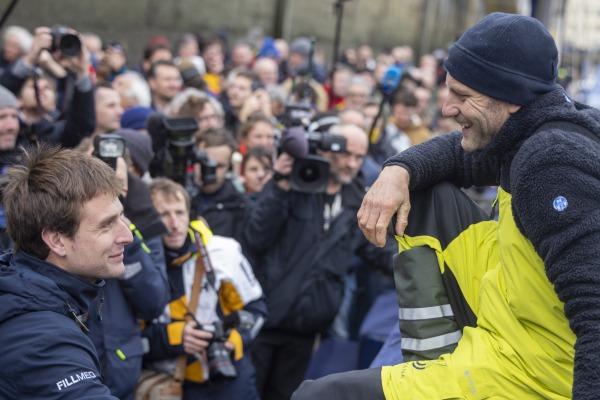
His early life
Like many others before him, Caudrelier owes the genesis of his sailing career to his parents, “My mother, a Parisian for whom Brittany represented the end of the world agreed to follow my father who hated the city and dreamed most of all of boats and horses,” he told Paris Match in 2009. And so his childhood was spent on the bay of Port-La-Forêt, where the all the great sailors of the time trained.
The young Caudrelier loved the beach and the ocean and went windsurfing as much as he could thanks to his dad’s extensive quiver of boards and fishing. And it was on his father’s cruising boat that he made his first longer sailing passages. Indeed, in his early youth, he asked only to spend the night sleeping on the boat alone. Unbeknown to his parents he then went for his first solo night sail just to see what the experience was like, returning back to the mooring before anyone had noticed, reporting back that he has slept perfectly.
At the request of his father, who had seem too many pro sailors of the time run into hard times financially, further education studies came before being allowed to sail full time. Accordingly he took his Merchant Marine officer qualifications at the same time taking on his first races, demonstrating his talent. Among his friends and rivals of the time are Franck Cammas, Armel Le Cléac’h and Sébastien Josse.
Caudrelier impresses, and 20 years ago wins the Solitaire du Figaro at the age of 30. Then he adds three Transat Jacques Vabre wins, two Volvo Ocean Races – “an extraordinary human adventure” and a Route du Rhum victory two years ago which really established his name as a solo racer in the eyes of the general public. He noted today that his major successes have arrived at ten year intervals.
He believed in his lucky star
This win is also testament to the continued assiduous development and optimisation of the Verdier designed Maxi Edmond de Rothschild which has been ongoing since its launch in 2017. They have learned from three consecutive unsuccessful round the world challenges for the Jules-Verne Trophy in 2020 and 2021 as well as again last year when the Gitana team had to return after just one day.
Nothing, then, is ever taken for granted as Caudrelier and co-skipper Erwan Israel – one of his routing cell on this race – know too well. Their Transat Jacques Vabre last November becomes a test of Caudrelier’s skills in fixing their boat and keeping going after damage to the steering system soon after the start and damage to a foil compromised their chance of winning the two handed race from France to Martinique.
Just over seven weeks ago Caudrelier set off from Brest saying “I believe I have a lucky star”. The skipper of the Maxi Edmond de Rothschild was in the leading duo from the first hours of the race. The start itself looked like a sprint which just continues and continues, “It’s a round the world race, we’re not in ‘Route du Rhum’ mode,” he maintains after two days of racing.
Forty-eight hours later the first significant depression comes with up to 50kts of wind and there is the first major damage a wave causing a break in the starboard front fairing.
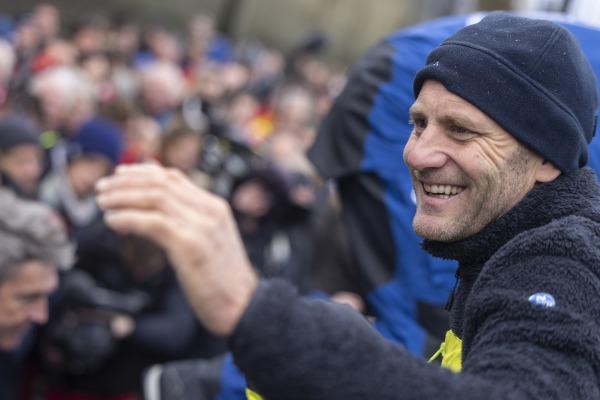
The duel, the charge and the need for caution is established.
But the pace does not drop as 26 year old rival Tom Laperche (SVR-Lazartigue) presses relentlessly hard. The intensity is at a maximum as the duo go head to head, as little as two miles apart at speeds of well over 30kts. On the 18th January speeds reach a peak and Caudrelier makes 828 miles in a 24 hour period, just less than the 851 miles Francois Gabart did in 2017 on Macif.
But just as the race is shaping up to be an extended duel, Laperche is the victim of a collision with an object which wrecks his main daggerboard and casing, causing a significant ingress of water. Laperche has to retire into Cape Town and Caudrelier’s lead is suddenly more than 1000 miles.
Across the Indian Ocean to Cape Leeuwin Caudrelier sets a new solo record, 1 day and 8 hours ahead of François Gabart’s 2017 mark), crossing the Indian Ocean in 8 days and 8 hours. The Pacific is less kind in terms of conditions but the French skipper confides that he does not pay attention to the records or data, “I am not fighting against the stopwatch, it would be stupid to press the boat too hard and break it in pursuit of a record, I take the pleasure in rolling out my route, optimizing my trajectory and choosing the right sails.”
Two days later he has to slow, putting his race ‘on hold’ for 48 hours as gusts of 50 to 70 knots are expected at Cape Horn and so he prefers to wait. And this is not the only concern. Icebergs are drifting near Cape Horm requiring increased vigilance.
Nonetheless his passage of the ‘Horn’ by day is majestic under a heavy, threatening sky. It is his first solo rounding and the first for the boat too. “This remains a legendary place and it’s magical.”
Above all, do not “sacrifice work out of impatience”
In fact, compared with the first third of his race during which he had the prefect ‘to order’ conditions – riding the same low pressure from Brasil’s Cabo Frio nearly to the Pacific – the final 7,000 miles back to Brest, climbing the South Atlantic felt like purgatory.
He has to stay inshore, upwind to avoid the South Atlantic high pressure, then facing a violent depression and always adapting to changing conditions. And as he remains the only skipper in the race not to have to make a technical stop for damage, he voices his nagging concern, “I live with a sword of Damocles hanging over me, my boat is not perfect. I only have one fear, and that is that it will stop.” He admits he finds himself “getting angry over nothing very much” recognising how much harder it is to manage this continuous tension.
And even the final runway into Brest proves problematic. A storm named Louis is approaching the Breton coast and the crossing of the Bay of Biscay looks treacherous.
“I’m not going to sacrifice the team’s work out of impatience.” He says and heads towards the Azores and the island of Faial. Stopping in the middle of a race starting again and winning is unusual in high-level sport. Michel Desjoyeaux of course did it, returning back to Les Sables d’Olonne after electrical damage after the start of the Vendée Globe (2008-2009), Loïck Peyron and Jean-Pierre Dick stopped in the Cook Strait before winning the Barcelona World Race (2010-2011). And motor sports fans will remember that Michael Schumacher already won the French GP in 2004 after four pit stops.
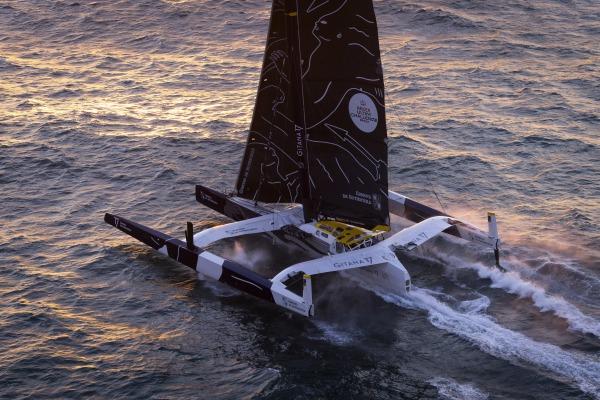
But having built a lead of the best part of 2000 miles Caudrelier could afford to stop in Horta for four days. He did some boat fixing, spent nights ashore in a proper bed had many showers and rested whilst he says always “having the impression of staying in the race”.
But the prudence pays off and Caudrelier and the Maxi Edmond de Rothschild complete the final 1200 miles at a steady, reduced pace. He eschews the chance to celebrate his 50th birthday and finish on the 50th day of the race to be doubly sure of coming in behind one last big depression rather than fall victim to the 40kts winds it held.
And so Caudrelier today completed his childhood dream, winning a solo race around the world. That it was the first ever for a fully foiling, giant ULTIM 33m multihulls adds to his remarkable achievement, a job very well done as he summits the very top peak of ocean racing.
© Alexis Courcoux / OC Sport – Pen Duick
Selected quotes from the day:
Charles Caudrelier on the victory pontoon,
“I was lucky because what happened to Tom (Laperche) could have happened to anyone but I trusted my lucky star and trusted in this boat and so I am really, really happy.”
“When Tom abandoned the race I was relieved in some senses because the pressure was relieved. As that point when I was racing with Tom I was kind of relieved to be able to do my own race. And you have to remember at the start of the race we did not really know if the boats were capable of finishing the race. I am happy to be able to say that I complete the course and I could have done it without stopping, I am very proud of that.”
“ At some point I realised that I was not achieving my lifelong goals such as the Vendée Globe and I had a period when I thought I would never be able to do this – win a solo round the world race – and so when I got the opportunity to do it I realised I could make that dream come true. It is a lifelong dream realised.”
“ I have been lucky to be able to go from one project to another, to win with Dongfeng and then I was really into doing the Vendée Globe but then this came along and it was just perfect. At the time my phone was ringing off the hook with other offers but even so I was surprised to get the call from Gitana team.
“ The rhythm of this race is so super intense. I am just happy to have got to the finish like I did. I am used to this racing round the world, being away, but I really missed my kids. And I missed good food but in then end I am happy how everything worked out.”
“ I had some complicated weather but had a great Cape Horn rounding. Not long after that I ripped my mainsail a little and I felt I was making some little mistakes, errors were creeping in, and so I had to really re-focus again. The team proposed a way to repair the mainsail myself rather than have to make a technical stop and so I really wanted to not stop, so I made the repair in a couple of hours hard work and I am still really proud of that.”
“There was some damages, the furling line broke, the foil system needed work it was a little damaged, I lost a bit of the foiling part of the rudder, some sails were damaged but everything was sorted out and I was always just trying to manage these things with my team who were incredible. When the fairing on the forward beam was damaged four days out I worried initially that the boat might not prove capable of finishing the race, but the team said everything no everything was OK.”
“ With the team we plan to do the Jules Verne Trophy challenge next wnter. The boat is incredible it such a good looking boat, I am so honoured to be able to sail it and I trust in it completely. The boat was so capable of doing the whole race, I trusted the way it was built, I trusted in our team and their work they have done, and after that it was up to me to manage the pace of the boat. This boat has a special place in my life, in my family, in our team and I hope it will go on to have a long life ahead of it.”
“ I have so many important moments in my life, winning La Solitaire du Figaro, winning the Route du Rhum….I don’t know what is the best achievement but when I won the Solitaire du Figaro it was huge at the time it was incredible at the time, and winning the Volvo like we did at the time in 2018 it was incredible, sharing it with a bunch of people I really loved, that was the hardest race of my life. In fact this race was a little bit smoother, it was a little bit easier, everything was in place to do a good performance, we had the boat and the team, so it is great to deliver.”
At the Press Conference this afternoon,
The condition of his boat. “I had two major damages. The first, I had from the first few days, caused by a violent wave, but the front beam fairing is not structural, it was only aerodynamics and we quickly found a solution. There were problems with the sail furlers, I broke some . I had repair materials on board but not enough. I also had watermaker problems and that could have made me stop the race. The second problem occurred after Cape Horn with this torn mainsail. We were going to make a 24-hour stop in Uruguay and ultimately, we saw that it wasn’t a big tear. The team came up with a great solution and I was able to leave after a few hours of fixing. There was also a problem with the starboard rudder fitting, we were going slower on one side. And then we had the problems that we had had in the Transat Jacques Vabre and that we were able to identify beforehand.”
His track record. “It’s certain that when I see the lines on my prize list, they are beautiful. I still see myself on my first Figaro but now, I can no longer act like a teenager. Tom Laperche calls me old, I think I changed categories. At one point I didn’t think I was going to tick the multihull boxes, the Volvo boxes. I didn’t check the Vendée Globe box but I have no regrets. It always went well. I have worked hard, I hope I have a little talent too but also a lot of luck to have been in the right place at the right time. I was lucky that Pascal Bidegorry, Franck Cammas and so many others trusted me.”
Optimizations. “I think we can still make even stronger boats. On the boat, perhaps we can add weight rather than gain aerodynamics. Even when I was at full tilt, I was at 80%, 85% of the boat’s polars possibilities. At first, I was very worried about losing performance. There are lots of details that we can optimize, especially on the foils.”
His future goals. “I checked a lot of boxes and I promised my children and my wife to calm things down. But also I am part of a team which has great objectives. I experienced from a distance the builds of Safran, Groupama 4, Gitana. It’s a great challenge to develop boats. I did a lot of one-designs and I always had complexes about it. I’m having a blast working and developing Gitana 18. It’s an incredible opportunity and it’s a great prospect. We will try to defend my title at the next Route du Rhum!”
The near future. “I want to take a break, go on vacation. That was planned from last Saturday but we will have to leave a little later than planned. My idea of a vacation is to go on the water with sailing, surfing. I very soon miss the sea when I’m far from it. And then there is this new boat project. It is like contemplating the start of the school year, I can’t wait to get back to my routine, to start this work. And I can’t wait for it to come to fruition.
